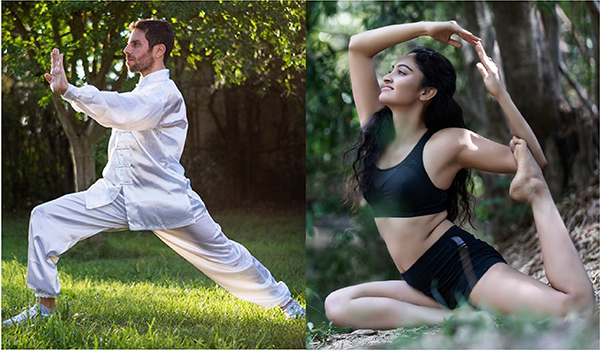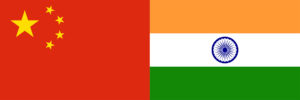
Three years ago, after attending and teaching qigong workshops at a festival in New Zealand. I wrote an article giving an analogy that I often use to help people compare Qigong and Yoga. The analogy is culinary. I compare Qigong to Chinese food, and Yoga to Indian Food. They look, smell, and taste quite different to each other. But this is their surface impression. When you dig below the surface you find that there are many similarities between them, and that their overall purpose is the same, even if the way in which they achieve it is a little different. You can find that blog post here.
I find it helpful to have a simple analogy like this to share with people to help them to look for the similarities of purpose underneath the more superficial differences. Particularly as yoga is so well known in the west now, while awareness of qigong is still rising. It gives people a starting point to open their minds and begin their exploration of qigong.
I have just attended another festival here where I live called The New Zealand International Yoga Festival, so I thought maybe it was time that I updated that article and went a bit deeper in comparing Qigong and Yoga.
Country of Origin Qigong VS Yoga

Qigong vs Yoga Country of Origin, Chinese and Indian Flags
Yoga comes from India, and Qigong comes from China. The history, culture, and philosophies of these two regions have developed quite differently, so it is natural that there are differences in the practices that evolved in these two great civilizations. But given their relatively close proximity to each other, there was also significant exchange of ideas between them as well. Historically this seems to have flowed more in the direction of from India to China, such as with the introduction of Buddhism to China, but there is also plenty of documented evidence of Chinese scholars visiting India as well. This cross-pollination of ideas inevitably showed up in similarities and correlations between their practices as well.
Definition of Name – Yoga VS Qigong

It is helpful for us to start by looking at the etymology of the names, because a name usually tries to encapsulate the most important concepts of a practice -to strip things down to their most basic and fundamental essence.
The term Yoga (योग ) comes from the word ‘yuj’ which means: to attach, join, harness, or yoke. The overall concept is one of uniting. This is interpreted differently by different groups. Originally the concept seems to have been very much focused on uniting with the Divine, in a spiritual or philosophical sense. In more modern use this is commonly interpreted as uniting mind with body.
Qigong (氣功) is made up of two words. Qi (氣) which means energy, and Gong (氣) which means work or skill. So quite simply it is the practice of working with and developing skill with energy. The term Qigong is relatively modern in usage, first appearing in Daoist literature in the early Tang Dynasty (618-907 AD), but was used to refer to practices dating back much further which had previously been know by other terms such as Neidan (internal alchemy), Xing qi (circulating qi), or Dao yin (guiding and pulling).
Concept of Energy in Qigong and Yoga
At the heart of both yoga and qigong is the concept of a vital life force energy that sustains life everywhere. In yoga it is referred to as ‘prana’ and in qigong it is the same ‘qi’ which makes up part of the name of the practice. Both of these practices work on harmonizing this energy within us. In yoga there is the concept of Chakras, and in qigong there is the concept of Dantien. Both of these refer to centres of energy which affect the surrounding tissues of the body, and also different aspects of the functioning of our whole being. Similarly in yoga there is the idea of nadis, which are channels that the energy flows through within the body, while in qigong these are referred to as meridians, and mapped out somewhat differently in the body. In practice though, yoga tends to focus more on the chakras without so much emphasis on the nadis, while qigong puts a strong emphasis on both the dantiens and the meridians. We will look more at these differences of practice focus later in this article.
Traditional Application of Yoga and Qigong
Given that both these traditions are thought to be up to 5000 years old. It is not surprising that they have developed into a great diversity of practices and applications. As such it is impossible to accurately characterize them all in a short article like this. You will always be able to find exceptions to the rule within the cornucopia of different yoga and qigong styles. With that in mind we will talk about what is most common amongst the different yoga and qigong styles in order to give a broad comparison of these different approaches to working with our vital energy.
Yoga started out as very much a spiritual practice. The first mention of the word yoga is found in the Rig Veda, the texts of the Vedic priests, the Brahman, and later in the collection of scriptures called the Upanishads. Later in the Classical period, Patanjali presented yoga systematically in the Yoga Sutras. He described yoga as having eight branches.
- Yama – attitudes towards our environment
- Niyama – attitudes towards ourselves
- Asana – physical postures
- Pranayama – breath control
- Pratyahara – control of the senses
- Dharana – concentration
- Dhyana – meditation
- Samadhi – enlightenment
Depending on how you interpret and understand these branches, 3 to 6 of them could be classed as ‘spiritual’ in nature, while only between 2 and 5 would be usually thought of as physical in practice. While over time yoga has been used alongside ayurvedic medicine as a way to enhance health, it was not originally intended as medicine in its own right. Ayurveda and yoga were considered to separate branches of Vedic knowledge. Similarly, while some modern martial artists may use yoga practice to enhance flexibility and for other benefits, there does not seem to be any strong historical connection between yoga and the martial arts in India.
Qigong on the other hand has its roots in the shamanistic dances of the Neolithic Chinese villagers. From its very earliest history it was associated with development and preservation of health. It is referred to in the earliest of Chinese Medicine texts such as the Huangdi Neijing of the legendary Yellow Emperor, considered to be the father of Chinese medicine, and its theory and practice continues to be foundation upon which other Chinese therapeutic modalities such as acupuncture, and even their views of herbalism are built upon.
Qigong also has a long and deep association with the martial arts. One of the most famous sets of qigong the Ba Duan Jin (Eight Pieces of Brocade), was developed by General Yeu Fei during the Southern Sung dynasty (1177-1279 CE) to make his soldiers strong and healthy. Also famously, the Buddhist Monk Bodhidharma travelled to China and taught the monks at the Shaolin temple breathing and movement exercises to keep them healthy and alert for their meditation practice. So the yoga of India does have an association with the martial arts, just indirectly, as these practices taught by Bodhidharma also went on to influence the Shaolin monks practice of martial arts for which they became famous. Throughout the Chinese martial arts, whether they are Buddhist, Taoist, or from some other lineage, we still see the strong importance of qigong within the training if practitioners wish to reach the highest level of their art.
Spirituality can also be found historically associated with qigong practice, but it is not so obviously intertwined. Qigong practices are used as tools towards enlightenment in many spiritual traditions, but there are many other traditions that don’t make a clear strong connection to spirituality within their qigong practices.
Modern Practice Yoga VS Qigong
In modern practice both qigong and yoga have become very focused on health and wellbeing as the most common aim of practitioners. You can still find the spiritual aspects of yoga, but you have to look a bit harder for them, as most yoga classes do not emphasize them to a great degree. Similarly, you can still find the martial and spiritual aspects of qigong, but you will need to look a bit further to find them as the most common teachings are strongly health oriented.
There is a bit of a differentiation between the specific nature of the health focus of yoga and qigong though. While both are used for general wellbeing and mental calm, in modern times yoga often also has a strong focus on external aesthetic looks. Qigong does not usually have this same focus on external aesthetic beauty, although there is no reason why it couldn’t. Instead, coming from its strong medical background, it tends to focus more on preventing or overcoming disease.
Methods Used in Qigong and Yoga
There is a great deal of correlation between the physical practices used in yoga and qigong. At the heart of both of them is harmonizing the use of Mind, Body, and Breath together to bring health and wellbeing outcomes.
There are many ways that these three can be combined into practice, most commonly including still and moving postures, specific breathing patterns, and meditations. Less common, but still found within modern teachings are the use of sound through singing and chanting, and specific dietary or cleansing practices.
While the fundamental elements of each are the same, how they finally manifest in practice on the surface can seem quite different. This is where the analogy of Chinese food and Indian food really comes to play. The deep principles may be very similar, but the end flavours are quite different.
Overall ‘Flavour’ Qigong VS Yoga

In terms of physical practice, yoga tends to emphasize exercises which involve being down on the ground on mats. There is a lot of flexibility and stretching, and a significant amount of strength required for the different postures. In addition to this the main emphasis is static postures or ‘asanas’ which practitioners attempt to hold for several minutes at a time. There are of course yoga variants which incorporate movement between postures, but overall a focus on the more static positions is more common.
The overall focus of yoga practice is quite external – on the external muscles of the body, and possibly on the activity of energy in the centres. The aesthetic is usually figure hugging clothing that allows freedom of movement. In Chinese terms we would describe it as a relatively yang practice.
In qigong, the most common practices are usually performed standing. There are qigong exercises that are performed sitting, and even down on the ground in ways that are similar to yoga postures, but overall standing practice is far more common. Most often in qigong the emphasis will be on smooth flowing movement throughout the qigong exercises – never stopping, as compared to the frequent holding of postures in yoga. There are static postures that form a very important part of qigong practice, but usually these are not physically challenging in the way that yoga asanas are, the challenge is more subtle, about fine tuning of posture and awareness, and they usually form a smaller part of the overall practice time.
In qigong the focus is usually very much internal, on the functioning of the organs in the body, and the flow of energy through the tissues, and less on the external muscles. The aesthetic is usually loose flowing clothes that allows freedom of movement… but in a different way from the typical yoga attire. In Chinese terms we would describe the most commonly practiced aspects of qigong as being relatively yin. More yang practices do exist, but they are not practiced as commonly.
Popularity and Awareness: Yoga VS Qigong
Yoga enjoys very high levels of popularity in the western world now. There is scarcely a westerner who would not have at least somewhat of an idea of what yoga is about if asked, and multiple yoga studios can be found in virtually every major city, and most small towns as well. There are abundant opportunities to attend classes, go on retreats, and even participate in instructor training courses in all of the many different styles of modern yoga. In addition to this all the many different products you may want to support you in your yoga practice: mats, blocks, straps, bolsters, clothing, music, ornamentation, instructional materials and so on are readily available. Yoga is easy to find, and the market is competitive. You could say that awareness is at close to saturation level.
On the other hand, if you ask a random selection of westerners what they know about qigong, a very high proportion will not know anything at all. But a few will have heard of it and may have even tried it, or have friends that have told them about their experiences. In relative terms awareness of qigong in the west is much lower than awareness of yoga, but it is growing FAST. While a relatively small percentage of the general population has some awareness of qigong, this is actually a far higher level of awareness than existed even ten years ago. You could compare qigong’s popularity as being similar to where yoga’s was about 30 to 40 years ago in the 80’s to early 90’s, where after a long period of relatively low awareness and participation rates, and being thought of as somewhat of a fringe interest, suddenly yoga hit the mainstream and growth in awareness and participation took off exponentially.
The exponential growth of qigong has begun, it is just at a very early point of its curve. As such it is still difficult to find good teachers in many cities, and opportunities for retreats and instructor training are limited. Interestingly, this has meant that online training has played a much larger role in the spread of qigong than it did for yoga. A big part of this is simply that the internet was not around when yoga was becoming popular, and as interested people look for qigong teachers in their area, they often turn to the internet when they can’t find any suitable classes. Of course Long White Cloud Qigong has played its part in this trend, bringing qigong to people all over the world through the online courses we offer.
Because of changes in society and technology, it seems likely that the growth of qigong will be even faster than the growth that yoga has experienced over the last few decades. The internet is playing a role in spreading information more quickly, and also in general people are more interested and prepared to look into mind body practices than they were previously. This is actually in large part due to the influence that yoga has already had in opening people’s minds to this sort of practice, and in fact there seems to be a rising interest in qigong amongst the existing yoga community. There are now many ‘yin’ yoga classes, and even some ‘yin and yang’ yoga classes, and many yoga teachers are starting to talk about ‘meridians’, instead of ‘nadis’, these terms of course coming from Chinese/qigong origins rather than from Indian/yoga sources.
It is interesting to see the beginnings of this convergence, and it makes sense in many ways that these two great mind/body/energy traditions may have value to offer each other. In fact, I have had many yoga teachers express to me that they are looking for something more to bring to their awareness of energy, and they see qigong as a good source for this; or that they like that qigong is not as hard on their body as yoga. There are some who are working quite overtly to bring the two together. At the yoga festival I have attended this weekend there were at least four workshop presenters whose practices were some kind of fusion of qigong and yoga – this is quite a change from previous years when I have attended and presented at festivals, where qigong was just starting to appear on the workshops schedules, but there was no merging between yoga and qigong. An emerging trend that is occurring other places in the world as well. In my opinion, none of what I have seen so far really makes a fully harmonious blend… yet. I think as people keep trying we will see better and better examples of bringing these two practices together in beneficial ways.
Summary of Qigong VS Yoga
For your convenience I have prepared a brief table summarising some of the differences between yoga and qigong below:
| Yoga | Qigong | |
| Origin | India | China |
| Core Focus | Spiritual Union | Skill with energy |
| Terminology | Prana, chakra, nadi | Qi, dantien, meridian |
| Traditional application | Spirituality | Medicine, martial arts, spirituality |
| Main modern application | Health and wellbeing | Health and wellbeing |
| Flavour and practice | Still asanas, down on ground, physically strenuous | Flowing movement, standing, gentle |
| Awareness and popularity | Close to saturation | Growing fast |
| Availability of training and products | Readily available | Available, but need to search. May need to utilize online resources. |
What This Means For You
I think the analogy I used years ago of Chinese food and Indian food is still a good one. Some people are going to like Chinese food, and other people are going to like Indian food, and some people are going to like both. There is no reason why you need to stay strictly to just one or the other. You may find in one things that you enjoy that you don’t get to the same extent from the other, and that is fine!
I hope that this comparison has given you a good overview of how yoga and qigong compare to each other, both in the flavour of their practices and their origins, and that this may help to guide you to what is most valuable and suitable for you in life at this time.
One way or another, you are going to see more and more qigong becoming available in the coming years as awareness and demand for it grows. You are also likely to see more and more instances of concepts from qigong and yoga coming together in new and emerging practices.
If you are interested in qigong, you are probably going to have to look a bit harder to find quality training and information than you need to for yoga. But the resources are emerging, particularly online. And Long White Cloud Qigong, along with other schools are working to make more services available to you, such as retreats, workshops, educational materials, and even clothing, to support you in your exploration of this fascinating practice.
Whether you are an experienced yoga teacher or practitioner looking for just a taste of Chinese food (qigong) to compare to the Indian food (yoga) you are used to, or you come from another background and are interested only in qigong, the practice has a lot of value and understanding to bring to you and your students. If you choose to pursue training it will enrich your life and your yoga practice, and you will be part of the rising wave of awareness and popularity of qigong which is currently spreading all over the world. You will be able to play your part in making this ancient mind body practice readily available to interested people in your community, so that they too can share in its many benefits.

If you are interested in qigong training, I would suggest starting with either Qigong Foundation Practices, or Between Heaven and Earth from Long White Cloud Qigong. These courses offer fascinating insights into how the energy meridians function inside us, and the connection between our minds, bodies, and emotions. You can do these courses for your own interest, or we also offer instructor certification programs so that you can also share these practices with others.
I hope that you have enjoyed this comparison of yoga and qigong. I’m actually headed to India now where I will be participating in another yoga retreat, so you can look forward to my next blog and vlog from there!
Yours in qi!
John Munro
Long White Cloud Qigong
7 Comments. Leave new
Another brilliant blog and vlog post. I have studied both yoga and Qigong for almost 20 year now and have found the practices have their own balances. I tend to practice Qigong to balance my mind with internal energies that are more dealing with my organs and then my yoga practice focuses on my connection to my external body, bone structure and alignment. I find they are in harmony when each practice is used as intended and not focusing on the idea of them being anything other than a benefit to the mind and body. I do believe the practices have similarities and can just be done without combining them into a single practice like Qiga or Yogong or some such fad. The practices already serve in similar ways that can be done alone as individual practices. It would be encouraging for Yogis and Qigong practitioners to simply learn from one another and find the common goals and see the advantages of both. My wife is a yoga instructor and I teach Qigong. We both learn from each other all the time.
Great comment 🙂
I teach both yoga and Qi Gong….love this blog. I have been including more and more QG into my yoga teaching….but rarely bring yoga into QG…not sure why. Can you speak to Chinese Yoga? I have been told it is a form Qi Gong yoga???
Some people refer to Qigong as Chinese Yoga, simply as a way to make a comparison and help people to understand that they are both practices working with the mind, body, and breath together. Ie, by using this term they are saying that qigong is the Chinese equivalent of yoga. Beyond that, there are some qigong practices that bear more resemblance than others to typical yoga practices, but I couldn’t comment further without knowing which particular practices someone is referring to.
Just in the past few months I have begun teaching Qigong at a Yoga studio to Yoga practitioners. I have explained that these practices compliment each other and that Qigong is more internally focused as Yoga focuses more on the external components of the body. I have received many comments after class that their energy awareness is heightened after Qigong and that they can feel the energy movement. Another interesting result is that they are surprised how tired their muscles feel from doing, by all appearances, less physical movements. It just goes to show you how deep of a practice Qigong is.
I appreciate your in-depth analysis and will share it with my students. I have been teaching yoga for 20 years and include qigong movement in each class. I find that it gives us a moment to get out of the structure of yoga and let go a little. I also find that for balance poses (mainly with elderly women) that if I do a qigong movement that shifts weight back and forth, then when I ask them to go into Tree, for example, they now focus better. Thanks for all you do. Am hoping to do instructor classes when possible.
I look forward to having you on some of the courses soon Christine 🙂